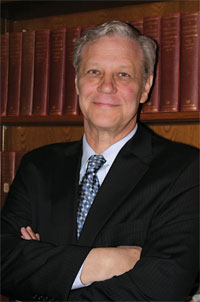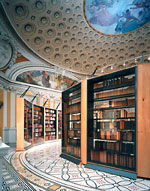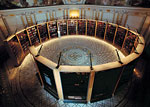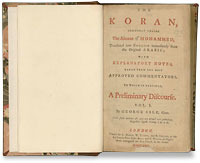Nation Building
At the Library of Congress, Mark Dimunation Collects for America
By Sarah L. CourteauSarah L. Courteau is literary editor of The Wilson Quarterly.

Mark Dimunation, chief curator of rare books and special collections at the Library of Congress. Photo taken June 2009 by Gail Fineberg.
Many book collectors and curators would give all their first editions for Mark Dimunation’s job. Since 1998, Dimunation has served as chief of the Library of Congress’s Rare Books and Special Collections Division. It is the largest rare book collection in North America, housed in the largest library in the world, a “huge theme park of materials,” as he describes it. The division contains some 850,000 items—including Charles Dickens’ walking stick, the contents of Abraham Lincoln’s pockets on the night he was assassinated, and The Bay Psalm Book, published in 1640, the first book printed in what became the United States.
On a May morning, Dimunation met me among a crowd of students and tourists in the ground-floor lobby of the library’s ornate Jefferson Building, across the street from the U.S. Capitol. Since the underground Capitol Visitor Center opened in December, curious newcomers have poured into the library through a connecting tunnel, filling the august building with life and noise. It is music to the ears of a man who has dedicated himself as much to making the library’s vast resources accessible as he has to building its collections. But he does wish the music of the people weren’t quite so loud for the sake of the researchers in the building.
A tall man with a shock of gray hair and dramatic features, he looks younger than his age—57. He wears a dark suit, the uniform of a job in which he may be called on with scarcely an hour’s notice to escort a foreign dignitary’s wife or a celebrity visiting a member of Congress on a guided tour. In fact, right after our interview he was to show Renaissance-era emblem books illustrated with hearts to actress Jane Seymour, which he thought would appeal to her because of the Open Hearts jewelry line she designed.
From the start of our conversation, Dimunation made it clear that he wasn’t going to do any professional crowing, let alone talk about his legacy, and he could not be budged from this stance. “It’s not who I am,” he insisted. “It’s where I am.”
Others are not so modest on his behalf. “Mark sets the bar for people in the profession not just in the United States but internationally, with his deep, deep love and knowledge of books,” says Winston Tabb, currently dean of university libraries and museums at Johns Hopkins. As associate librarian at the Library of Congress, he hired Dimunation away from Cornell, where he was curator of rare books at the Carl A. Kroch Library. “I think of him as one of my greatest acquisitions at the Library of Congress,” Tabb says, with evident satisfaction.
Ultimately, it was the mission of the nation’s library that lured Dimunation from his academic perch at Cornell. The Library of Congress’s materials “belong to the American people, and they tell our story,” says Dimunation. “It’s very infectious stuff. I know it sounds like it’s what you would expect a large national agency to say, but the experience of it all is captivating. Scratch any curator in this library and you will find that they fundamentally believe that. So that’s the privilege of working at the Library of Congress, and it’s probably what you’re not prepared for when you come. You’re not prepared for the level of passion you develop in this quest to build collections that have meaning to the American people.”
One of Dimunation’s most ambitious quests has been to rebuild the collection of books that Thomas Jefferson sold to Congress in 1815, to replace the holdings lost when the British burned the Capitol and the Library of Congress the previous year. For $24,000, Jefferson parted with nearly 6,500 volumes he had amassed in his personal and eclectic library at Monticello. Thirty-six years later, two-thirds of that collection was lost in another fire at the Library of Congress, caused by a defective chimney flue.
When he was hired, Dimunation was charged with reconstructing Jefferson’s original collection in two years, in time for the library’s bicentennial in 2000. Now, recounting these cavalier instructions, he laughs. The job proved tremendously challenging. Jefferson’s original notes about his inventory could be cryptic, and some of the items that are still missing are extremely obscure. Some may no longer exist. Today, roughly 300 white placeholders, the ghosts of volumes yet to be located, mark lacunae in the permanent installation that showcases the library for visitors.
“For me the best part of it was the actual journey through the mind and world of Jefferson,” Dimunation says. “I was in a sense building Jefferson’s collection, but it was clear to me that I wasn’t building it at all in the same way that he did, which forced me to understand how he went about it, why books came in the way they did, why he was drawn to certain things, and why I can say at this point, ‘Yes, he would have bought that’; ‘No, he wouldn’t have bought that.’ You sort of embrace a mentality around thought and idea and study and collecting and owning.”
One of the things that distinguished Jefferson’s collection—and rendered it suspect, in the eyes of some in Congress as they contemplated the 1815 purchase—is its scope. There were books in foreign languages and books not believed germane to the needs of Congress (Dimunation made the news in 2007 when he delivered Jefferson’s 1764 copy of the Quran for the swearing in of Minnesota representative Keith Ellison, the first Muslim elected to Congress). Today, Jefferson’s sensibility continues to guide acquisitions at the library. “If it’s a record of human endeavor that records thought, that documents an event, that explains motive,” says Dimunation, “then I think that’s an important part of the documentation within the culture and experience.”










